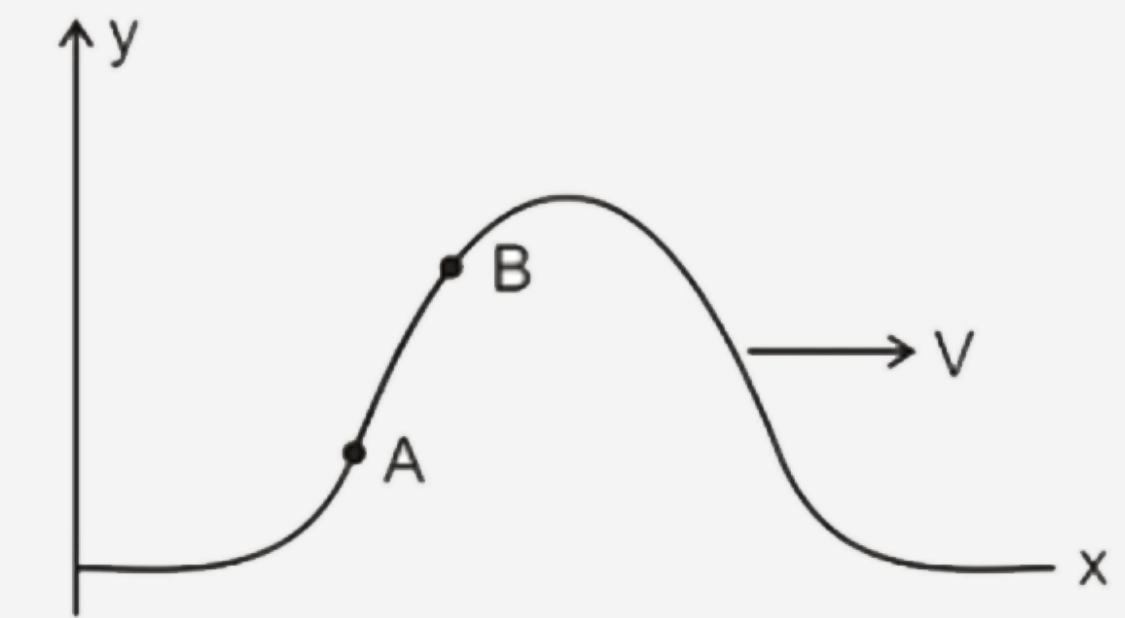A boy is jerking one end of a taut string. The wave train propagating to the right has been shown in the figure.

(a) Why the crests are farther apart as we move away from the boy.
(b) Which particle on the string a or b is having higher speed?
The correct Answer is:(a) The boy is jerking the string with gradually increasing frequency
(b) Particle 'a'
Step by step video, text & image solution for A boy is jerking one end of a taut string. The wave train propagating to the right has been shown in the figure. (a) Why the crests are farther apart as we move away from the boy. (b) Which particle on the string a or b is having higher speed? by Physics experts to help you in doubts & scoring excellent marks in Class 11 exams.
Updated on:21/07/2023Topper's Solved these Questions
Similar Questions
A wave pulse is generated in a string that lies along x- axis. At the points A and B, as shown in the figure, if RAandRB are the ratio of wave speed to the particle speed respectively then:

View SolutionA string, of length L, clamped at both ends is vibrating in its first overtone mode. Answer the following questions for the moment the string looks flat
(a) Find the distance between two nearest particles each of which have half the speed of the particle having maximum speed.
(b) How many particles in the string have one eighth the speed of the particle travelling at highest speed?
View Solution
Knowledge Check
The displacement of a vibrating string versus position along the string is shown in the figure. The periodic wave have a speed of 10.0cm/s. A and B are two points on the string.

What is the wavelength of the wave?A3.0 cmB6.0 cmC9.0 cmD12 cmThe displacement of a vibrating string versus position along the string is shown in the figure. The periodic wave have a speed of 10.0cm/s. A and B are two points on the string.

What is the amplitude of the wave?A2 mmB4 mmC12 mmD8 mmThe displacement of a vibrating string versus position along the string is shown in the figure. The periodic wave have a speed of 10.0cm/s. A and B are two points on the string.

What is the frequency of the wave?A0.60HzB0.90HzC1.7HzD1.3Hz
A transverse simple harmonic wave propagating to the right along a string is shown in the figure At the moment shown, out of the particles labeled as p,q,r,s and T which point has its velocity and acceleration in opposite directions ? T R
View SolutionA particle A of mass 2m is held on a smooth horizontal table and is attached to one end of an inelastic string which runs over a smooth light pulley at the edge of the table. At the other end of the string there hangs another particle B of mass m, the distance from A to the pulley is l. The particle A is then projected towards the pulley with velocity u.

(a) Find the time before the string becomes taut, and shown that after the string becomes taut, the initial velocity of A and B is 4u/3.
(b) Find the common velocity when A reaches the pulley (assume that B has not yet reached the ground).
View SolutionTia a stone to one end of a string. Take the other end in your hand and rotate the string so that the stone moves along a circle as shown in figure 1.1 (a). Are you applying any force on the stone? In which direction is this force acting ? How will you stop this force from acting ? What will be the effect on the stone ?

View SolutionA string has linear mass density m=0.1kg/m. A L=60cm segment of the string is clamped at A and B and is kept under a tension of T=160N [The tension providing arrangement has not been shown in the figure]. A small paper rider is placed on the string at point R such that BR=20cm. The string is set into vibrations using a tuning fork of frequency f.
(a) Calculate all values of f below 1000Hz for which the rider will not vibrate at all.
(b) Calculate all values of f below 1000Hz for which the rider will have maximum oscillation amplitude among all points on the string.

View SolutionThe displacement of a vibrating string versus position along the string is shown in the figure. The periodic wave have a speed of 10.0cm/s. A and B are two points on the string.

What is the difference in phase between the points A and B?
View Solution